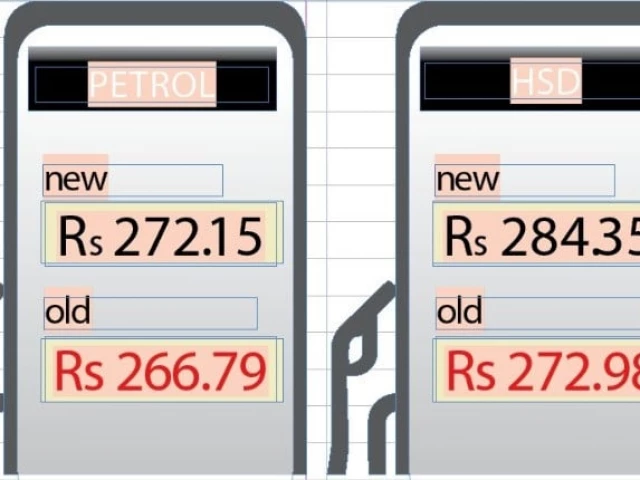Islamabad:
The government made the prices of petroleum products on Tuesday to Rs11 per liter for the second half of 2025 in a regressive stage which would exacerbate the economic difficulties encountered by the ordinary man.
This is the second consecutive increase in petrol and diesel prices since the start of the new fiscal year on July 1. On June 30, the government increased fuel prices to RS10 for the first half of the current month which ended on Tuesday.
In addition, the Regulatory Authority for Petroleum and Gas (OGRA) has announced a reduction in the price of reefted liquefied natural gas (RLNG) for the current month, while the rate of kerosene oil and light diesel oil also lowered.
According to a notification issued by the finance division, the price of gasoline increased from RS5.36 – from RS266.79 to RS272.15 per liter, while high -speed diesel (HSD) increased from RS11.37 per liter – from RS272.98 to RS284.35 for the period from July 16 to 31.
This last adjustment of petrol and HSD prices reflects persistent volatility on the world oil markets. It also shows the government’s budgetary constraints to achieve its ambitious income targets because it already invoices the highest oil levy rate (PL) on petroleum products to receive income.
The government said it had made the last decision on OGRA’s recommendations and the ministries concerned. “The government has decided to revise the prices of petroleum products for the fortnight from July 16, depending on the recommendations of OGRA and the ministries concerned,” he said.
OGRA had recommended the increase in prices for petroleum products based on RS78.02 per liter PL on petrol and RS77.01 on HSD. He also assumed the margin of equalization of interior freight (IFEM) to RS8.89 per liter in petrol and 6.04 rupees on HSD. The adjustment of the exchange rate was calculated at RS3 per liter on petrol and RS2 on HSD.
Diesel is widely used in agriculture and freight transport, and any price increase has a direct impact on the cost of goods and services. Essence, on the other hand, fuels motorcycles and cars, and serves as an alternative to compressed natural gas (GNC), in particular Punjab, where GNC stations depend on imported LNG.
The new price increase should further expand the gap between revenues from stagnant households and the increase in the cost of living. Analysts have warned that without budgetary space or targeted subsidies, the weight of global oil volatility will continue to be transmitted to end users.
The government had the space to save consumers from the current oil prices by reducing the PL rate, but it did not compromise on income collection and, therefore, adopted the full impact of the increase in oil prices on the world consumer market.
On July 1, the federal government considerably increased the prices of gasoline and HSD, awarding the increase to the volatility of the world market in the middle of the Iran-Israel war. The gasoline was increased from RS8.36 to RS266.79 per liter, and HSD from RS10.39 to RS272.98, on the basis of the recommendation of OGRA.
Pakistan imports petroleum products to meet around 85% of its local consumption, while 15% of needs are met by crude oil produced locally. Consumers are currently paying more than RS77 per liter in PL. The current year’s budget also includes a new carbon tax, pushing fuel prices more.
Meanwhile, on the deregulated market, kerosene oil becomes cheaper from RS3.10 and the price of the LDO decreased from RS1.85, while OGRA, by a notification, announced a reduction in RLNG prices for the current month at the end of a slight decrease in ex-Navire price (of).
According to the OGRA notification, the RLNG prices for the SUN Northern Gas Pipelines Limited (SNGPL) and the Su Southern Gas Company (SSGC) had undergone changes in the transmission and distribution segments.
For SNGPL, the new transmission price has been set at $ 10.8338 per million British thermal units (MMBTU), against $ 11,01,54, reflecting a drop of $ 0.1816, or 1.65%. The distribution price was revised at $ 11.5787 per MMBTU, against 11,7816, a drop of $ 0.2029, or 1.72%.
Likewise, the SSGC transmission price increased from $ 9.7284 per MMBTU in June to $ 9.4713 in July, a drop of 2.64%. However, the distribution price also increased from $ 10,8650 per MMBTU to $ 10.5737, a reduction of $ 0.2913, or 2.68%.




